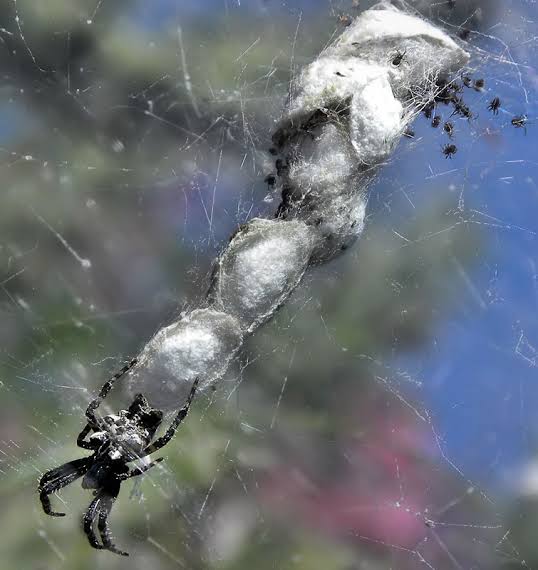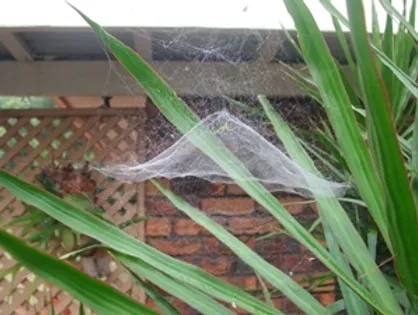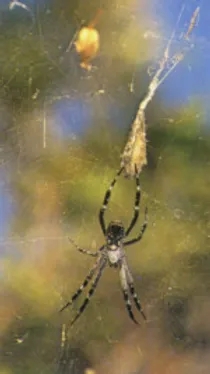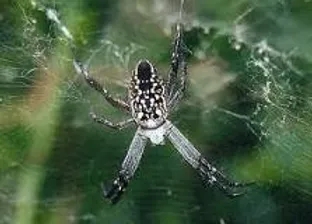Is the tent-web spider poisonous?
They are harmless to humans. Double-tailed tent spiders build large nonsticky webs of two parts – a tangle web and a finely-meshed horizontal orb web. The females of the species are larger than the males and they may vary considerably in colour.

There are many different species of Tent Spiders in Australia. The largest Tent Spider is 19mm long and is found in the northern parts of Australia. The female has a grey head and a black body with white spots. The tiny male Tent Spider has an orange body. The Latin name for the Tent Spider is Cyrtophora spp.
The Dome Tent spider, (Cyrtophora moluccensis) is the largest spanning the width of a man’s hand. The long body is strongly variable in colour with a broad black to rusty red stripe for most of the back and bright yellow and white spots along the edges.
The Russian Tent spider (Cyrtophora hirta) is a rarely seen small pale spider with an oval body usually hiding in the white cap at the top of the tent-like web.
Scoop web spiders (Cyrtophora exanthematica) have a brown long triangular body that is difficult to find among the cluster of dead leaves.
tent spiders Habitat:
The Tent Spider is found all over the north and east regions of Australia and around some islands close to Ausralia’s coastline. The Tent Spider makes an orb web that looks like a tent. The spider makes its web horizontally across the ground (which can reach anywhere up to 4 metres in length) with the centre pulled vertical so the web is shaped like a tent.
The Tent-web spiders, although technically orb-web spiders, do not build orb webs. Their tent-like, highly complex non-sticky web is sometimes considered a precursor of the simplified orb-web. The webs are always positioned in trees or in gardens with suitable foliage.
Inside the tent is another tent, if an insect flies in the tent, the spider covers up the torn web to hide the insect from any other prey. They are found in shaded warm areas – gardens, litter, trees, walls and paths. This spider is most often seen in Summer, north from Coffs Harbour, NSW.

Prey: The Tent Spider eats whatever flies into its web; flies, grasshoppers, butterflies and other insects. The Tent Spider does not eat birds.
Breeding: The Tent Spider has a green egg sac placed in the web. The spider makes four woolly green egg sacs which are attached to the top of the web. The female dies and she leaves her young alone to fend for themselves.
Venom: The venom has no effect on humans, only to insects.

Genus Cyrtophora (family Araneidae)
Identification
Female Tent-Web Spiders of the genus Cyrtophora are medium–large web-building spiders, with three species commonly found in eastern Queensland. The largest and most commonly encountered species, Cyrtophora moluccensis, has banded legs with a humped abdomen that can vary widely in colour depending on the individual. Most specimens have a reticulated abdominal colour pattern with maroon, white and black, while other specimens are darker, often with green or orange markings. Juveniles are mostly green in colour. Another species, Cyrtophora hirta, is smaller and paler, with a uniformly creamy-white abdomen. A third species, Cyrtophora exanthematica, is brown or orange-brown, usually with two thin, wavy white stripes on the abdomen, and two forked projections above the spinnerets. Males of all three species are very small in comparison, and can often be found in or near the webs of females.

Web
Each species of Tent-Web Spider builds a characteristic horizontal orb-web, constructed using a fine silken mesh. The web of C. moluccensis is large and expansive, in the shape of a broad dome, with a tangle of numerous supporting silken threads above the dome. These tangled threads are used to intercept insects in flight, such that they are knocked off course and drop down onto the domed web. The spiders hang permanently under their domes in the middle of their webs waiting for prey, and often locate themselves in the full summer sunshine. In some places, the spiders can form huge colonies. The web of C. hirta is smaller, and the middle is pulled up acutely in the form a pointed tent, with the upper part lined with thick, white silk. The spider hides within this white silken tent, waiting for prey. The web of C. exanthematica is usually constructed in dense vegetation, and is less tent- or dome-shaped than the other two species. The spiders camouflage their webs with dead leaves attached to the tangle of supporting silken threads, and rather than sitting upside-down in the middle of the platform, they hide under dead leaves near the edge of the web.
Distribution and habitat
Tent-Web Spiders can be found throughout much of Australia, but are especially abundant in the tropical and subtropical north and east. In Queensland, all three species can be found in northern and eastern regions south to the New South Wales border, in wet and dry forests. They are extremely common residents of gardens and other urban habitats, including around Brisbane, where the large webs of C. moluccensis are often a permanent feature of many backyards during the warmer months.
Bite
Tent-Web Spiders are timid animals and not aggressive, and will usually run to the edge of their web platform or drop to the ground if disturbed. Like other orb-weaving spiders, bites may result in mild local symptoms (pain, numbness or swelling). As for all bites and stings, if a bite does occur and symptoms persist, seek medical attention.
Remarks
Ten-Web Spiders are familiar to most Queenslanders, and C. moluccensis in particular is an important and welcome predator of backyard insects along the eastern seaboard. Females of both C. moluccensis and C. hirta construct their egg sacs in the middle of their webs, and the dull-green egg sacs of C. moluccensis are notable for being the target of an unusual parasitic sarcophagid fly. Females can sometimes be seen actively defending their egg sacs from fly attack, vigorously shaking their webs. Cyrtophora exanthematica, in contrast (and unusually for an orb-weaving spider), lays its large egg sac within a tangled nursery web away from the main capture web, and stays guarding the egg sac for some time.
